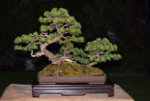amatbrewer
Shohin
It may be a little off the track from OP’s original question but while I will not disagree with the excellent commentary and advice given here, I would like mention one positive aspect (at least for me) of cheap material that I am not sure gets touched on.
I find I am willing to take risks (real or perceived) with cheap material that I would not with my more valuable plants. As such I find this cheap material invaluable in learning new skills and practicing techniques. And to my surprise a few actually have resulted in plants with some potential. E.g. the free lilac that I almost killed while experimenting, but what survived looks like it may be a nice mame in a few years.
And as for the failures that do survive? Well they make nice gifts for those who don't know any better: "What is that? You like that one over there? I have had it for a few years now, but consider it my gift to you. You are welcome." ;-P
I find I am willing to take risks (real or perceived) with cheap material that I would not with my more valuable plants. As such I find this cheap material invaluable in learning new skills and practicing techniques. And to my surprise a few actually have resulted in plants with some potential. E.g. the free lilac that I almost killed while experimenting, but what survived looks like it may be a nice mame in a few years.
And as for the failures that do survive? Well they make nice gifts for those who don't know any better: "What is that? You like that one over there? I have had it for a few years now, but consider it my gift to you. You are welcome." ;-P

